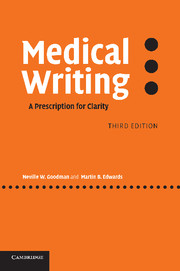Book contents
- Frontmatter
- Contents
- Preface to the first edition
- Preface to the third edition
- Acknowledgements
- PART I PROBLEM: THE ILLNESS
- 1 Introduction
- 2 The malaise of medical manuscripts
- PART II SOLUTION: SYMPTOMATIC RELIEF
- PART III PRACTICE: RECUPERATION
- Appendix: examples to rewrite
- References and further reading
- Index
2 - The malaise of medical manuscripts
Published online by Cambridge University Press: 23 November 2009
- Frontmatter
- Contents
- Preface to the first edition
- Preface to the third edition
- Acknowledgements
- PART I PROBLEM: THE ILLNESS
- 1 Introduction
- 2 The malaise of medical manuscripts
- PART II SOLUTION: SYMPTOMATIC RELIEF
- PART III PRACTICE: RECUPERATION
- Appendix: examples to rewrite
- References and further reading
- Index
Summary
We think in words. We form our ideas in words. If doctors write descriptions of clinical trials that confuse readers assumed to be of equal knowledge and understanding, then that is the responsibility of the writers not the readers, who might justifiably wonder whether the conduct of the clinical trials had been similarly confused. (The difference between ‘responsibility’ and ‘fault’ serves a purpose here. We have already indicated that writers should not necessarily be blamed for their bad habits.)
Medicine is a practical subject so here is an example of confused writing, taken from a clinical report. The investigators were relating the rate of infusion of a drug to its concentration in the blood. They wrote,
The infusion rate was then increased and blood was taken 4, 8, 12, and 20 minutes after [our italics] the new target concentration had been achieved.
The meaning of this sentence is clear: they wanted there to be a higher concentration of drug, which would have a greater effect, and blood was taken to ascertain what happened after the new, desired concentration had been reached. This is a reasonable thing to want to know; after all, if the concentration varied, then the effect could be unpredictable.
The meaning is absolutely clear; but the trouble is that it is not what the investigators meant. They were interested in how quickly the concentration reached its new steady state after the rate of infusion had been increased; they took blood 4, 8, 12 and 20 minutes after taking the action that sought to produce a new target concentration, that is, after altering the rate of infusion.
- Type
- Chapter
- Information
- Medical WritingA Prescription for Clarity, pp. 5 - 22Publisher: Cambridge University PressPrint publication year: 2006



